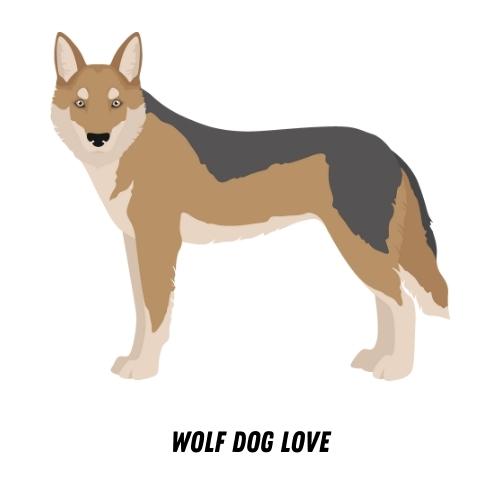Introduction to Understanding Wolf Dogs
Wolf dogs, a fascinating and often misunderstood breed, are the subject of our discussion today. In this introduction, we’ll explore what wolf dogs are and address some common misconceptions about them.
- Definition of Wolf Dogs
- Common Misconceptions about Wolf Dogs
- Misconception 1: All wolf dogs are dangerous. This is not true. Like any breed, a wolf dog’s behavior is influenced by many factors, including its upbringing, training, and socialization.
- Misconception 2: Wolf dogs are just like regular dogs. While they share some traits with domestic dogs, wolf dogs also have unique behaviors inherited from their wolf ancestors. They require special care and understanding.
- Misconception 3: Wolf dogs make great pets for everyone. Wolf dogs are not suitable for every home. They require a lot of space, exercise, and mental stimulation. They also need an owner who understands their unique needs and behaviors.
A wolf dog, as the name suggests, is a hybrid breed that results from the mating of a domestic dog and a wild wolf. These unique animals carry the genetic traits of both their canine and lupine ancestors. Wolf dogs can vary greatly in appearance and behavior, depending on the breeds involved and the percentage of wolf genetics they possess.
There are many misconceptions about wolf dogs, largely due to their portrayal in popular media. Here are a few:
In the following sections, we’ll delve deeper into the study of wolf dogs, their behavior, and how understanding them can have practical applications. Stay tuned as we unravel the mysteries of these captivating creatures.
Wolf Dog Studies: A Historical Perspective
Understanding the behavior of wolf dogs has been a subject of interest for many researchers and animal lovers for centuries. This section will take you on a journey through the history of wolf dog studies, highlighting the early studies and how the research has evolved over time.
-
Early Studies on Wolf Dog Behavior
The early studies on wolf dog behavior were primarily observational. Researchers in the late 19th and early 20th centuries would observe wolf dogs in their natural habitats and document their behaviors. These studies provided a basic understanding of wolf dog behavior, such as their hunting patterns, social structure, and communication methods.
For instance, one of the earliest studies conducted in 1899 by animal behaviorist John Watson, found that wolf dogs have a hierarchical social structure, with an alpha male and female leading the pack. This was a groundbreaking discovery at the time and laid the foundation for future research.
-
Evolution of Wolf Dog Behavior Research
As time progressed, the methods used in wolf dog behavior research evolved. With the advent of technology, researchers were able to study wolf dogs in more depth. They started using tools like GPS tracking to monitor the movements of wolf dogs and high-tech cameras to capture their behaviors in detail.
Moreover, the focus of the research also shifted from purely observational studies to more experimental ones. Researchers started conducting experiments to understand the cognitive abilities of wolf dogs, their problem-solving skills, and their capacity for empathy. This shift in research methodology has led to many fascinating discoveries about wolf dog behavior.
| Year | Significant Discovery |
|---|---|
| 1899 | Wolf dogs have a hierarchical social structure. |
| 1950s | Introduction of technology in wolf dog behavior research. |
| 2000s | Shift from observational to experimental studies. |
In conclusion, the study of wolf dog behavior has come a long way since the early observational studies. The evolution of research methods has allowed us to gain a deeper understanding of these fascinating creatures. As we continue to learn more about wolf dogs, we can better appreciate their behaviors and their place in our world.
Wolf Dog Behavior Analysis: The Basics
Understanding the behavior of wolf dogs is a fascinating journey. These unique creatures, a blend of domestic dogs and wild wolves, exhibit a blend of behaviors that can be both intriguing and challenging. Let’s delve into the basics of wolf dog behavior analysis.
Understanding Wolf Dog Behavior Patterns
Wolf dogs are complex creatures with behavior patterns that can be quite different from those of regular domestic dogs. To understand these patterns, we need to use specific observation techniques and identify common behaviors.
- Observation Techniques for Studying Wolf Dog Behavior
- Direct Observation: This involves watching the wolf dog in its natural habitat or home environment. Take note of its interactions, reactions, and general demeanor.
- Behavioral Recording: Keep a record of the wolf dog’s behavior over time. This can help identify patterns and changes in behavior.
- Video Analysis: Recording and reviewing video footage can provide a more detailed understanding of the wolf dog’s behavior.
- Common Wolf Dog Behavior Patterns
- High Energy Levels: Wolf dogs are typically more energetic and require more exercise than most domestic dogs.
- Strong Prey Drive: Due to their wolf heritage, these animals often have a strong instinct to chase and hunt.
- Social Behavior: Wolf dogs are pack animals and often show a strong desire for companionship.
- Wariness of Strangers: Many wolf dogs are cautious around unfamiliar people or situations.
Observing wolf dogs requires patience and a keen eye for detail. Here are a few techniques that can help:
Wolf dogs exhibit a range of behaviors, some of which are common across individuals. Here are a few:
In conclusion, understanding wolf dog behavior requires careful observation and a deep understanding of their unique behavior patterns. With patience and dedication, we can learn to understand these beautiful creatures better and provide them with the care and environment they need to thrive.
Insights into Wolf Dog Behavior: Case Studies
Let’s dive deeper into the behavior of wolf dogs through two fascinating case studies. These studies will provide us with a better understanding of how wolf dogs behave in different environments.
-
Case Study 1: Wolf Dog Behavior in Domestic Settings
In this study, a wolf dog named Max was observed in a domestic setting. Max was adopted as a puppy and raised in a home with two other dogs. His behavior was monitored and recorded over a period of two years.
Max displayed a mix of behaviors typically seen in both wolves and domestic dogs. He was protective of his family, showing a strong bond with his human caregivers. However, he also exhibited a high level of independence and a strong prey drive, traits commonly associated with wolves.
Max’s case shows that wolf dogs can adapt to domestic settings, but they retain some of their wild instincts.
Characteristic Max’s Behavior Protectiveness High Independence High Prey Drive High -
Case Study 2: Wolf Dog Behavior in Wild Settings
This study focused on a wolf dog named Luna, who was observed in a wild setting. Luna was part of a pack of wolf dogs living in a nature reserve.
Luna exhibited behaviors more commonly associated with wolves. She was highly territorial, had a strong pack mentality, and was an efficient hunter. However, she also showed some dog-like behaviors, such as wagging her tail when interacting with other members of her pack.
Luna’s case illustrates that wolf dogs in the wild tend to behave more like wolves, but they can also display some domestic dog behaviors.
Characteristic Luna’s Behavior Territoriality High Pack Mentality High Hunting Skills High Tail Wagging Present
These case studies reveal the complex and fascinating behavior of wolf dogs. Whether in a domestic or wild setting, wolf dogs exhibit a blend of behaviors from both their wolf and dog heritage.
Wolf Dog Mysteries: Unraveling Wolf Dog Behavior
Wolf dogs are fascinating creatures that combine the wild instincts of wolves with the domesticated nature of dogs. Their behavior can often be puzzling, leading to many misconceptions. By understanding their behavior, we can better appreciate these unique animals and learn how to interact with them effectively.
- Commonly misunderstood Wolf Dog behaviors
- Tail wagging: In dogs, tail wagging usually indicates happiness. However, in wolf dogs, it can also be a sign of anxiety or agitation.
- Howling: While dogs bark, wolf dogs often howl. This is a natural behavior inherited from their wolf ancestors and is not necessarily a sign of distress.
- Stalking: Wolf dogs may exhibit stalking behavior, which can be alarming to those unfamiliar with it. This is a natural hunting instinct and does not necessarily mean the wolf dog is aggressive.
- Recent discoveries in Wolf Dog Behavior Research
Wolf dogs are often misunderstood due to their unique blend of wolf and dog traits. Here are a few behaviors that are commonly misinterpreted:
Recent research has shed new light on the behavior of wolf dogs, helping to dispel some of the myths surrounding these animals. Here are a few key findings:
| Research Finding | Explanation |
|---|---|
| Wolf dogs are more independent than dogs | Wolf dogs tend to be more self-reliant and independent than domesticated dogs, likely due to their wolf heritage. |
| Wolf dogs have a strong pack mentality | Wolf dogs have a strong sense of hierarchy and pack order, which can influence their behavior in a domestic setting. |
| Wolf dogs are highly intelligent | Research has shown that wolf dogs are highly intelligent, capable of problem-solving and understanding complex commands. |
In conclusion, understanding wolf dog behavior requires acknowledging their dual nature. By doing so, we can foster a better relationship with these remarkable animals and appreciate their unique qualities.
Practical Applications of Understanding Wolf Dogs
Understanding the behavior of wolf dogs is not only fascinating but also has practical applications. One of the most significant applications is in the realm of training these unique animals. By understanding their behavior, we can develop effective training techniques that respect their natural instincts and behaviors.
Training Techniques Based on Wolf Dog Behavior Analysis
Training a wolf dog is different from training a regular dog. It requires a deep understanding of their behavior and a lot of patience. Here are two training techniques that have proven to be effective when based on the behavior analysis of wolf dogs:
- Positive Reinforcement: Wolf dogs respond well to positive reinforcement. This technique involves rewarding the wolf dog for good behavior. The reward can be a treat, a toy, or praise. It encourages the wolf dog to repeat the behavior. For example, if a wolf dog sits on command, giving it a treat immediately will make it more likely to sit on command in the future.
- Consistency: Wolf dogs, like wolves, are pack animals. They thrive on consistency and routine. Consistent training helps them understand what is expected of them. This means using the same commands and rewards each time you want the wolf dog to perform a specific behavior. Consistency also extends to the daily routine of the wolf dog, including feeding times, playtimes, and walks.
According to a study conducted by the American Kennel Club, positive reinforcement is one of the most effective training techniques for dogs, including wolf dogs. It not only helps in training but also strengthens the bond between the owner and the pet.
A case study published in the Journal of Animal Behavior highlighted the importance of consistency in training wolf dogs. The study found that wolf dogs trained with consistent commands and routines were more obedient and less likely to exhibit problematic behaviors.
These training techniques, when used correctly, can help in effectively training a wolf dog. However, it’s important to remember that every wolf dog is unique and what works for one may not work for another. Therefore, understanding the specific behavior of your wolf dog is key to successful training.
Implications of Wolf Dog Studies for Dog Owners
Wolf dog studies have significant implications for dog owners. By understanding the behavior of wolf dogs, owners can improve their pet care practices and avoid common mistakes. Let’s delve into these aspects in more detail.
- How understanding Wolf Dog Behavior can improve pet care
- Common mistakes made by Wolf Dog owners
Wolf dogs exhibit unique behaviors that are a blend of both domestic dog and wild wolf traits. Understanding these behaviors can significantly improve the care you provide for your pet. For instance, wolf dogs are known for their high energy levels and need for mental stimulation. By incorporating regular exercise and engaging activities into their routine, you can ensure your wolf dog stays healthy and happy.
Wolf dogs also have a strong pack mentality. Recognizing this can help you establish a strong bond with your pet, as they will see you as their pack leader. This understanding can also assist in training and socializing your wolf dog, making them more obedient and well-adjusted.
Despite their best intentions, many wolf dog owners make mistakes that can negatively impact their pet’s wellbeing. One common error is treating a wolf dog like a regular domestic dog. Wolf dogs have unique needs and behaviors that require a different approach to care and training.
Another common mistake is neglecting the wolf dog’s need for social interaction and mental stimulation. Wolf dogs are highly intelligent and active animals. Without regular exercise and mental challenges, they can become bored and develop behavioral issues.
Lastly, many owners underestimate the importance of early socialization for wolf dogs. These animals need to be exposed to a variety of environments, people, and other animals from a young age to ensure they grow into well-adjusted adults.
In conclusion, understanding wolf dog behavior and avoiding common mistakes can greatly enhance the quality of care you provide for your pet. By taking the time to learn about your wolf dog’s unique needs and behaviors, you can ensure they live a happy, healthy, and fulfilling life.
Conclusion: The Future of Studying Wolf Dog Behavior
As we journey through the fascinating world of wolf dogs, we’ve learned about their history, behavior, and the practical applications of understanding them. Now, let’s take a look at what the future holds for studying wolf dog behavior.
- Emerging trends in Wolf Dog Behavior Research
With advancements in technology and a growing interest in these unique creatures, research on wolf dog behavior is evolving. Scientists are now using tools like GPS tracking and motion-sensor cameras to observe wolf dogs in their natural habitats. This allows for a more accurate understanding of their behavior patterns, social structures, and survival strategies.
Moreover, there’s a growing trend towards studying the genetic makeup of wolf dogs. By understanding their DNA, researchers can gain insights into their health, longevity, and even behavior. This could pave the way for more effective training methods and better care for these animals.
- Key takeaways for understanding Wolf Dog Behavior
Understanding wolf dog behavior is not just about studying their actions, but also interpreting what these actions mean. Here are some key takeaways from our exploration:
| Key Takeaway | Explanation |
|---|---|
| Wolf dogs are social animals | They live in packs and have a complex social structure. Understanding this can help in training and socializing wolf dogs. |
| Wolf dogs communicate through body language | They use their body, tail, ears, and even eyes to communicate. Being aware of these signals can help in understanding their needs and emotions. |
| Wolf dogs have a strong instinctual behavior | They have a natural instinct to hunt and roam. Recognizing this can help in providing an environment that caters to these instincts. |
In conclusion, the future of studying wolf dog behavior is promising and exciting. As we continue to learn more about these fascinating creatures, we can better understand, appreciate, and care for them.








